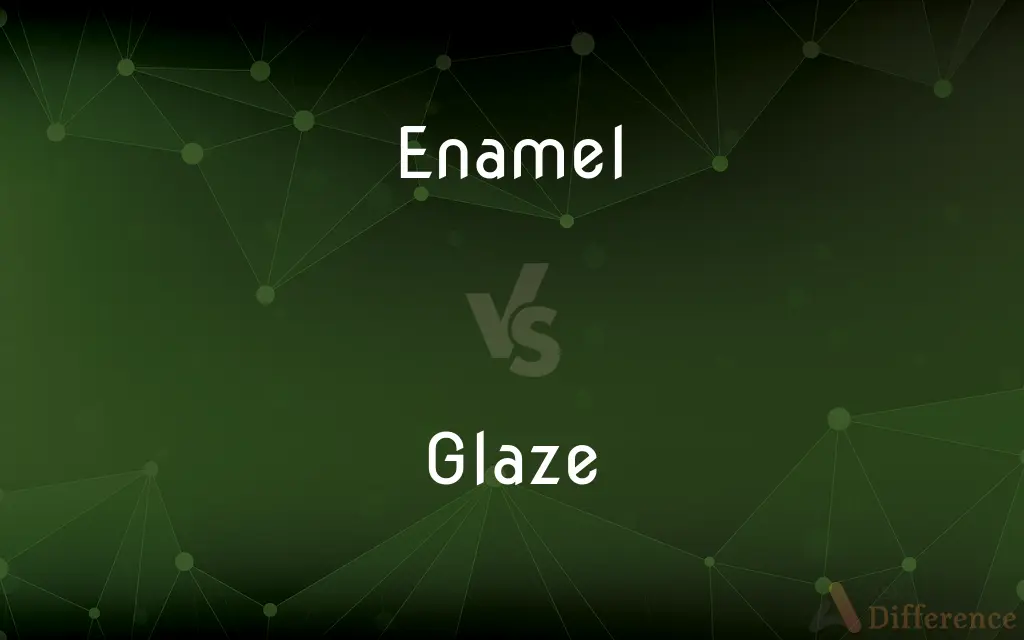Enamel vs. Glaze — What's the Difference?
By Fiza Rafique & Urooj Arif — Updated on March 14, 2024
Enamel is a durable coating, while glaze is a glossy finish.

Difference Between Enamel and Glaze
Table of Contents
ADVERTISEMENT
Key Differences
Enamel, often used in dentistry and art, refers to a hard, durable, and usually glossy coating that's applied to various surfaces for protection and decoration. In dentistry, it's the tough, outermost layer of a tooth, naturally protecting it from decay. Whereas, glaze is a glass-like coating applied to pottery, ceramics, and sometimes metal or wood, which becomes vitreous (glassy) when fired at high temperatures. Glazes are used to decorate and waterproof ceramic objects, enhancing their appearance and strength.
Enamel coatings in art and industry are known for their durability, providing a hard, often colorful finish that resists weathering and corrosion. Glaze, on the other hand, not only adds a glossy or matte finish but also affects the texture and color of the ceramic piece, contributing to its aesthetic and functional qualities.
The process of applying enamel involves either painting or spraying the enamel onto the surface and then firing it at high temperatures to fuse it to the base material. Glazing involves coating the pottery with a glaze mixture and then firing it in a kiln, where the glaze melts and forms a glassy surface.
While enamel is celebrated for its resilience and ability to adhere to a variety of surfaces, glaze is prized for its contribution to the artistry of ceramics, through a wide range of colors, finishes, and effects that can be achieved depending on the composition of the glaze and the firing process.
Both enamel and glaze serve protective functions, but their aesthetic contributions differ significantly, with enamel offering a sleek, uniform appearance and glaze providing depth, texture, and a wide range of artistic effects.
ADVERTISEMENT
Comparison Chart
Composition
Powdered glass fused to a surface
Glass-like coating that vitrifies upon firing
Usage
Dentistry, art, metalwork
Pottery, ceramics
Finish
Durable, glossy
Glossy, matte, varied textures
Function
Protection, decoration
Waterproofing, decoration
Application Process
Painted or sprayed and fired
Coated and fired in a kiln
Compare with Definitions
Enamel
Hard, protective outer layer of a tooth.
Brushing your teeth helps protect the enamel from decay.
Glaze
Glass-like coating on ceramics.
The potter applied a clear glaze to the vase before its final firing.
Enamel
Artistic technique involving fused glass powder.
The enamel jewelry featured intricate designs and vibrant colors.
Glaze
Finish that adds glossiness and color.
The glaze gave the pottery a rich, deep blue hue.
Enamel
Durable, glossy coating for various materials.
The enamel on the vintage car preserved its vibrant color.
Glaze
Coating that affects the texture of ceramics.
The matte glaze added a soft, tactile quality to the sculpture.
Enamel
Type of paint with a glossy finish.
He used a blue enamel for the metal gates to match the house.
Glaze
Substance used to waterproof pottery.
After glazing, the clay bowl was no longer porous.
Enamel
Protective or decorative layer in art and manufacturing.
The enamel-coated signs were known for their longevity.
Glaze
Artistic element in ceramics.
The artist experimented with different glazes to achieve unique effects.
Enamel
A vitreous, usually opaque, protective or decorative coating baked on metal, glass, or ceramic ware.
Glaze
A thin smooth shiny coating.
Enamel
An object having such a coating, as in a piece of cloisonné.
Glaze
A thin glassy coating of ice.
Enamel
A coating that dries to a hard glossy finish
Nail enamel.
Glaze
A coating of colored, opaque, or transparent material applied to ceramics before firing.
Enamel
A paint that dries to a hard glossy finish.
Glaze
A coating, as of syrup, applied to food.
Enamel
(Anatomy) The hard, calcareous substance covering the exposed portion of a tooth.
Glaze
A transparent coating applied to the surface of a painting to modify the color tones.
Enamel
To coat, inlay, or decorate with enamel.
Glaze
A glassy film, as one over the eyes.
Enamel
To give a glossy or brilliant surface to.
Glaze
To fit, furnish, or secure with glass
Glaze a window.
Enamel
To adorn with a brightly colored surface.
Glaze
To apply a glaze to
Glaze a doughnut.
Glaze pottery.
Enamel
An opaque, glassy coating baked onto metal or ceramic objects.
Glaze
To coat or cover thinly with ice.
Enamel
A coating that dries to a hard, glossy finish.
Glaze
To give a smooth lustrous surface to.
Enamel
The hard covering on the exposed part of a tooth.
Glaze
To be or become glazed or glassy
His eyes glazed over from boredom.
Enamel
A cosmetic intended to give the appearance of a smooth and beautiful complexion.
Glaze
To form a glaze.
Enamel
(transitive) To coat or decorate with enamel.
Glaze
(ceramics) The vitreous coating of pottery or porcelain; anything used as a coating or color in glazing. See glaze (transitive verb).
Enamel
(transitive) To variegate with colours, as if with enamel.
Glaze
A transparent or semi-transparent layer of paint.
Enamel
(transitive) To form a glossy surface like enamel upon.
To enamel card paper; to enamel leather or cloth
Glaze
A smooth edible coating applied to food.
Enamel
(transitive) To disguise with cosmetics, as a woman's complexion.
Glaze
(meteorology) A smooth coating of ice formed on objects due to the freezing of rain; glaze ice.
Enamel
A variety of glass, used in ornament, to cover a surface, as of metal or pottery, and admitting of after decoration in color, or used itself for inlaying or application in varied colors.
Glaze
Broth reduced by boiling to a gelatinous paste, and spread thinly over braised dishes.
Enamel
A glassy, opaque bead obtained by the blowpipe.
Glaze
A glazing oven; glost oven.
Enamel
That which is enameled; also, any smooth, glossy surface, resembling enamel, especially if variegated.
Glaze
(transitive) To install windows.
Enamel
The intensely hard calcified tissue entering into the composition of teeth. It merely covers the exposed parts of the teeth of man, but in many animals is intermixed in various ways with the dentine and cement.
Glaze
To apply a thin, transparent layer of coating.
Enamel
Any one of various preparations for giving a smooth, glossy surface like that of enamel.
Glaze
(intransitive) To become glazed or glassy.
Enamel
A cosmetic intended to give the appearance of a smooth and beautiful complexion.
Glaze
(intransitive) For eyes to take on an uninterested appearance.
Enamel
To lay enamel upon; to decorate with enamel whether inlaid or painted.
Glaze
To furnish (a window, a house, a sash, a case, etc.) with glass.
Two cabinets daintily paved, richly handed, and glazed with crystalline glass.
Enamel
To variegate with colors as if with enamel.
Oft he [the serpent]bowedHis turret crest and sleek enameled neck.
Glaze
To incrust, cover, or overlay with a thin surface, consisting of, or resembling, glass; as, to glaze earthenware; hence, to render smooth, glasslike, or glossy; as, to glaze paper, gunpowder, and the like.
Sorrow's eye glazed with blinding tears.
Enamel
To form a glossy surface like enamel upon; as, to enamel card paper; to enamel leather or cloth.
Glaze
To apply thinly a transparent or semitransparent color to (another color), to modify the effect.
Enamel
To disguise with cosmetics, as a woman's complexion.
Glaze
To cover (a donut, cupcake, meat, etc.) with a thin layer of edible syrup, or other substance which may solidify to a glossy coating. The material used for glazing is usually sweet or highly flavored.
Enamel
To practice the art of enameling.
Glaze
To become glazed of glassy.
Enamel
Relating to the art of enameling; as, enamel painting.
Glaze
Broth reduced by boiling to a gelatinous paste, and spread thinly over braised dishes.
Enamel
Hard white substance covering the crown of a tooth
Glaze
A glazing oven. See Glost oven.
Enamel
A colored glassy compound (opaque or partially opaque) that is fused to the surface of metal or glass or pottery for decoration or protection
Glaze
Any of various thin shiny (savory or sweet) coatings applied to foods
Enamel
A paint that dries to a hard glossy finish
Glaze
A glossy finish on a fabric
Enamel
Any smooth glossy coating that resembles ceramic glaze
Glaze
Coating for fabrics, ceramics, metal, etc.
Enamel
Coat, inlay, or surface with enamel
Glaze
Coat with a glaze;
The potter glazed the dishes
Glaze
Become glassy or take on a glass-like appearance;
Her eyes glaze over when she is bored
Glaze
Furnish with glass;
Glass the windows
Glaze
Coat with something sweet, such as a hard sugar glaze
Common Curiosities
What is the purpose of a glaze on pottery?
Glaze serves to decorate, waterproof, and strengthen pottery, adding a glass-like finish.
How is glaze applied to ceramics?
Glaze is typically applied by dipping, brushing, or spraying onto the ceramic piece before firing in a kiln.
What is enamel used for?
Enamel is used for protection and decoration on metal, glass, ceramics, and as the outermost layer of teeth.
Can enamel be repaired if it's damaged?
While small chips or cracks in enamel can sometimes be repaired, the process can be complex and may not fully restore the original appearance.
Is enamel safe for food surfaces?
Food-safe enamels are available, but it's important to ensure that any enamel used on surfaces that will come into contact with food is specifically rated as safe for this purpose.
What's the difference between enamel paint and regular paint?
Enamel paint is known for its hard, glossy finish and durability, making it suitable for surfaces that require a tough, washable coating.
Is enamel more durable than glaze?
Enamel is known for its exceptional durability, especially in industrial applications, while glaze's durability depends on its formulation and the firing process.
Can both enamel and glaze be colored?
Yes, both can be colored using various pigments, allowing for a wide range of artistic expression.
What makes enamel glossy?
The glossiness of enamel comes from its glass-based composition and the process of fusing it to a surface at high temperatures.
Can enamel be applied to any surface?
Enamel can adhere to various surfaces, but it is most commonly used on metal, glass, and ceramics.
Are there different types of glazes?
Yes, there are many types of glazes, including matte, glossy, crystalline, and textured, each achieved through different formulations and firing conditions.
How does the composition of a glaze affect its color?
The composition of a glaze, including the types of minerals and oxides used, directly influences its final color after firing.
How does the firing temperature affect glaze?
The firing temperature can significantly affect the appearance, texture, and strength of a glaze, with different glazes requiring specific temperature ranges to vitrify properly.
Can enamel and glaze be used together?
In some artistic applications, enamel and glaze can be used together, especially in mixed-media pieces, but their different firing temperatures and compositions require careful planning.
Can glaze be used on materials other than ceramics?
While primarily used on ceramics, glazes can also be applied to some metals and wood in artistic applications.
Share Your Discovery

Previous Comparison
Client vs. Agent
Next Comparison
Expound vs. PropoundAuthor Spotlight
Written by
Fiza RafiqueFiza Rafique is a skilled content writer at AskDifference.com, where she meticulously refines and enhances written pieces. Drawing from her vast editorial expertise, Fiza ensures clarity, accuracy, and precision in every article. Passionate about language, she continually seeks to elevate the quality of content for readers worldwide.
Co-written by
Urooj ArifUrooj is a skilled content writer at Ask Difference, known for her exceptional ability to simplify complex topics into engaging and informative content. With a passion for research and a flair for clear, concise writing, she consistently delivers articles that resonate with our diverse audience.















































